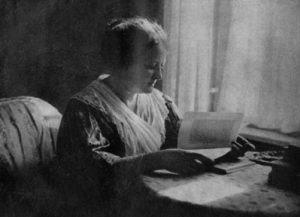Lily Braun (1865-1916)
“Live she must, and earn wages—that is the iron law of capitalism, the whip which keeps driving her month after month…But those who know her are aware that this is destroying her”
The aristocrat Lily Braun (1865-1916) joined the bourgeoisie women’s in Germany in the early 1890s, and became a member of the radical Association for the Well-Being of Women (Verein Frauenwohl) in 1894. Two years later, she officially declared herself a member of the Social Democratic Party of Germany (SPD). However, Braun found herself isolated from most of the other female party members and leaders, who mostly came from the working-class. She often clashed with the female leaders of the social democratic women’s movement over questions of strategy and tactic and became known as an ardent critic Clara Zetkin (1857-1933). Still, Braun remained active in politics and became an well-known writer.
Braun was born in July 1865 in Halberstadt, in the Prussian province of Saxony, as the daughter of Hans von Kretschmann, General of the Infantry in the Prussian Army, and his wife Jenny, née von Gustedt. Raised according to the Prussian virtues of order and discipline at changing places throughout her father’s military career, she nevertheless developed a direct and open personality. From 1893 Lily Braun was briefly married to Georg von Gizycki (1851–1895), a professor of philosophy at the University of Berlin, who was associated with the SPD without being officially a member, which would have cost him his job. After her first husband’s death, she married in 1896 Heinrich Braun (1854–1927), who was a social democratic politician and a publicist. The couple had one son, Otto Braun, a highly talented poet who was killed in 1918 at the Western Front.
Much of Braun’s feminist activism focused on gaining legal protections for mothers and children (especially single mothers and their children). Specifically, she advocated for women’s economic independence and maternity insurance for working mothers. Braun attempted to merge the politics of middle-class feminism and democratic socialism in her works and strived for reform, not revolution. This ultimately created ideological conflict between her and Clara Zetkin, the prominent female leader in the SPD and in the socialist feminist movement. The two disagreed especially on the topic of feminist militancy. Zetkin promoted the use of revolutionary measures and militant action to advance the movement for women’s emancipation, but Braun felt that progress could be best achieved through gradual reforms. Yet, Braun and her colleagues agreed on some essential points.
Braun became well known in Germany for her first large work Die Frauenfrage: Ihre geschichtliche Entwicklung und ihre wirtschaftliche Seite (The Women’s Question: Historical Development and Economic Sspect), published in 1901, which was very positively received. In 1906, she published Die Mutterschaftsversicherung: ein Beitrag zur Frage der Fürsorge für Schwangere und Wöchnerinnen (Maternity Insurance: A Contribution the Question of Care for Pregnant Women and those in Childbed), with which she demanded more protection of working mother. In her fictional work Mutterschaft. Ein Sammelwerk für die Probleme des Weibes als Mutter (Motherhood. An Anthology on the Problems of the Woman as Mother) from 1912, Braun called attention to two fictionalized (but representative) mothers—a middle class mother who who could stay at home, and a working class mother who needed to earn an income and hardly sees her children. The housewife scolds her children and is hardly kind to them because on top of running the household, she bears the brunt of the parenting responsibilities with little help from her husband. By contrast, the working mother is much gentler with her children because she is away from them all day and can “come to them with a heart full of love.” Braun intended to paint a picture of two mothers “neither [of whom could] be a real mother” because of societal structures working against her. The woman who stays at home is angry, overworked, and resentful, while the working mother cannot be present in her children’s lives. Even more recognition as a writer brought her the two-volume book Memoiren einer Sozialistin—Lehrjahre (Memoirs of a Socialist—Apprenticeship Years) and Memoiren einer Sozialistin—Kampfjahre (Memoirs of a Woman Socialist—Years of Struggle), published in 1909 and 1911.
Braun supported the SPD policy that supported World War I. She encouraged her son to volunteer. Deeply concerned about the fate of her son at the battlefront, Lily Braun died in her home in Zehlendorf (today part of Berlin) from the consequences of a stroke at the age of 51.
Braun remains relevant today not just for her contributions to the women’s movement in Germany and Europe, but also as an example of the disparities within the women’s movement. It is easy to assume that feminists worldwide agreed on all points and seamlessly worked towards the same cause. This was absolutely not the case, and in fact, the women’s movement was rife with ambiguities and contradictions. As demonstrated by the relationship between Braun and Zetkin, for example, even members of the same political groups conflicted. Understanding Braun’s role in the movement can help students of the women’s movement see all of its complexities, as well as the unity that occurred in spite of ideological tension.
Nicole Sotelo, History and Political Science, Class of 2019
Sources
Literature and Websites
- “Lily Braun.” Encyclopædia Britannica, at https://www.britannica.com/biography/Lily-Braun (Accessed April 20, 2018).
- Lischke, Ute. Lily Braun, 1865-1916: German Writer, Feminist, Socialist. Rochester, NY: Camden House, 2000.
- Meyer, Alfred G. “Lily Braun.” Signs 6, no. 2 (1980): 355-361.


